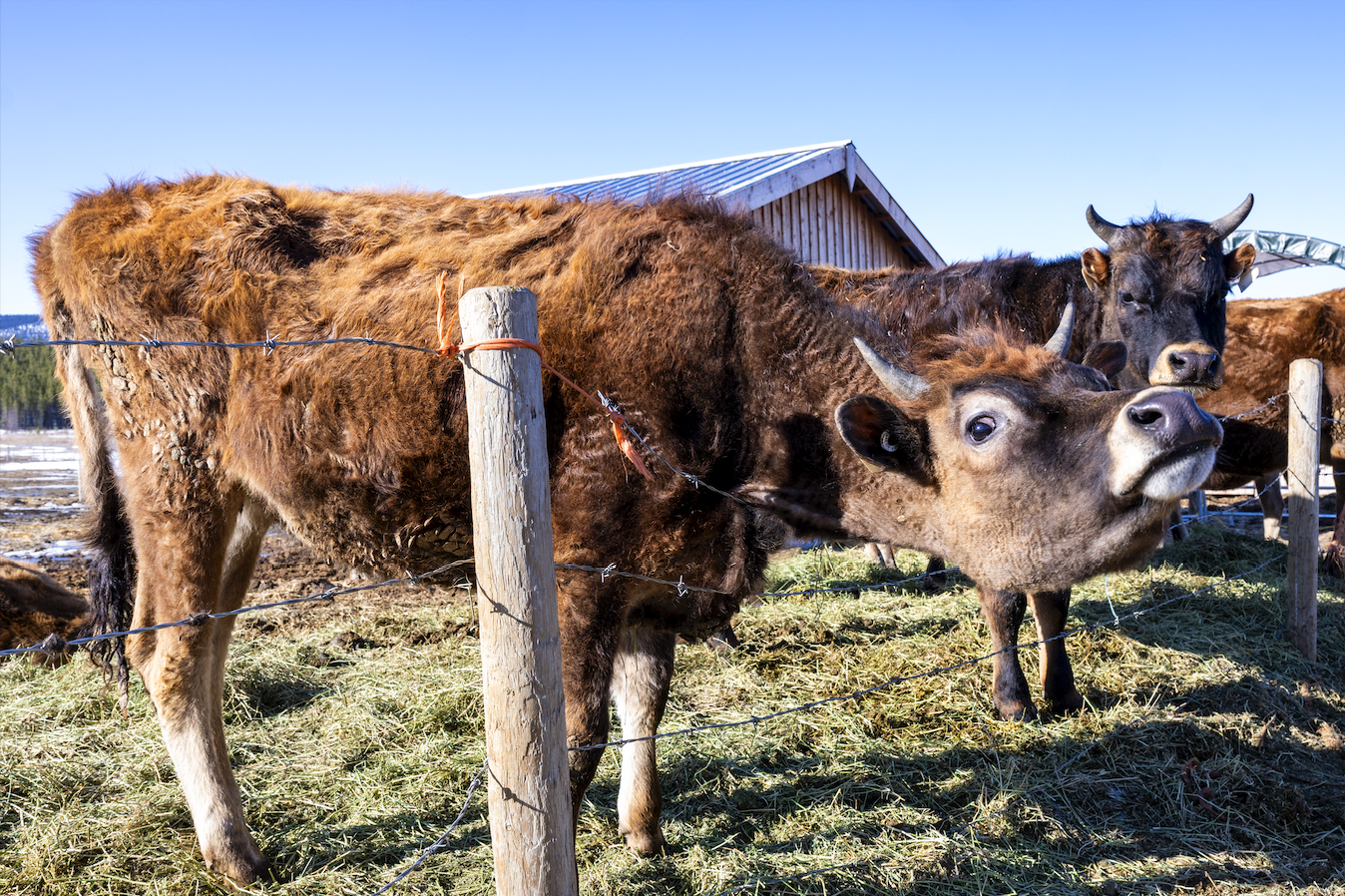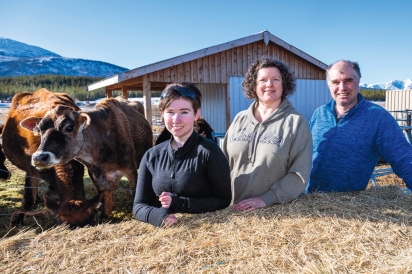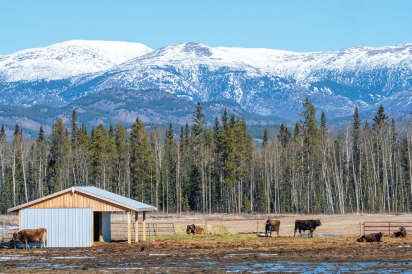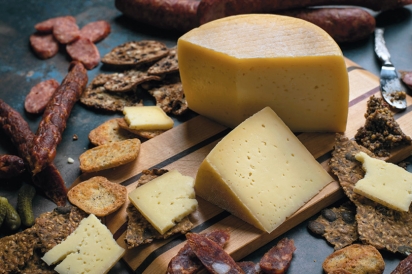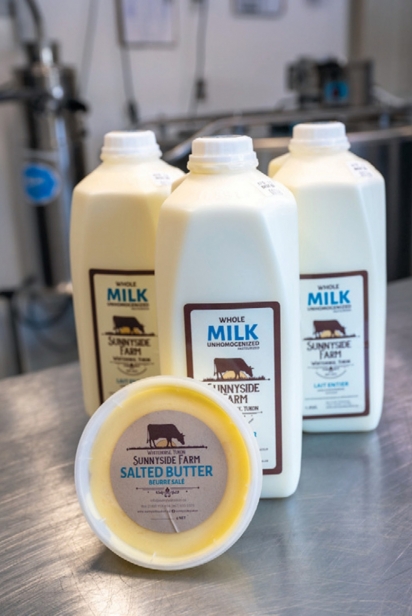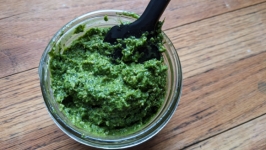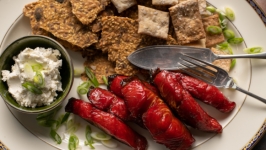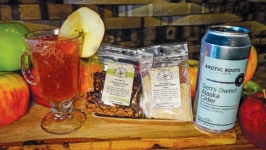Going to Extremes: Dairy Farming in the Yukon
Dairy Farming in the Yukon
Yukon dairy farmer Krista Roske holds up a two-quart milk jug with a red rubber nipple fastened to its top.
“Anybody feel like feeding a calf?” I step forward. Krista’s daughter Kate shows me how to tip the bottle so the milk flows. I lean over the fence, and Coal, one of the younger calves in the herd, latches on with a vengeance.
“Careful,” says Kate. “Don’t hold the bottle too close to your stomach. The calves tend to bunt.” (Bunting the udder is a calf’s strategy to stimulate the flow.) A minute later Coal throws up his head, nipple in his mouth, and lunges forward. The bottle jerks back towards me. Oh, yes, that would’ve hurt.
This sunny morning in late March is my first time out to see Sunnyside Farm, Krista and Jason Roske’s dairy operation in the Ibex Valley, west of Whitehorse, though I’d been enjoying their milk, cream, and butter since they started production two years ago.
The 86-acre farm is nestled in a wide valley ringed by mountains, their peaks still gleaming with snow. A couple of hay barns, a cow barn, a calving shed, a milking parlor, and a spotless “clean room” for processing milk make up the essential infrastructure, plus several corrals for keeping the milk herd separate from the dry herd.
The Roskes acquired the land in 2012 and spent a year clearing trees. Their first products were vegetables and eggs, sold at market or through local food co-ops. In 2022, they switched to dairy farming.
At that time, Krista says, “Nobody else was selling milk, locally, and we do like a challenge.” Two years later, the Roskes have weathered their share of challenges, like Jason dragging heavy hoses all over the property in winter to supply cows with water (cows drink a lot of water, and even more in winter), keeping brand new calves warm when the temperature plunges to -50° F, timing pregnancies so the supply of milk stays steady, and footing the enormous insurance, capital, and feed costs.
The physical labor falls largely to Jason. Krista has a full-time job but helps when she can, and though Kate is willing, she doesn’t have the strength for some tasks.
When they started, says Krista, “People told us dairy farming is one of the hardest things you can do. They were right. But we have a passion for it.”
That passion, and the support of the community, keep them going.
“We really get the sense that people want us to succeed,” says Krista. The Roskes recount their successes—they’ve expanded their product line from the original, two-quart bottles of whole milk to include pints of 35 percent cream, and half-pounds of butter sold in reusable, microwaveable, dishwasher-safe plastic tubs. (At first, Jason Roske pressed the butter into rectangles by hand, but, as anyone who’s made butter at home knows, that becomes really hard on the wrists.)
Sunnyside Farm milk is now sold in several grocery stores and specialty shops including Landed Bakehouse in Whitehorse and BonTon and Company in Dawson, and one of their regular customers is the First Nations Education Directorate at F.H. Collins high school in Whitehorse. They reserve butter and cream for two specialty shops—Tum Tum’s Black Gilt Meats at the corner of the Takhini Hot Springs Road and the North Klondike Highway, and Cultured Fine Cheese in Whitehorse. (Jason notes that any given production period yields 25 pounds of butter or 18 liters of cream, since the butter is made from the cream.) This summer they’ll add “calf-size” bottles of chocolate milk to their booth at the weekly Fireweed Community Market in Whitehorse.
Perhaps best of all, the Roskes have assembled a fine team of helpmates—a nutritionist and a dairy consultant are a phone call away, a hoof trimmer visits regularly, and the Yukon vet program subsidizes the cows’ vaccination regime against mastitis and pneumonia. A young farm worker, a stalwart for the past several years, will return this summer with an agricultural technician diploma.
“We’re very grateful to have such a good team around us,” says Krista.
Of the Roskes’ herd of 28 Jersey and Jersey-mix cows, six are typically in milk at a time, producing about 100 gallons of milk per week. (Cows have a 40-week gestation period. They are “dried off” for 45 to 60 days before calving, and for seven to ten days after, while they’re still producing colostrum.) If the calves are female, or heifers, they’re raised to become milk cows, and if they’re male, or steers, they become meat animals. In the Yukon, it costs about $4,500 CAD to raise a calf from heifer to milk cow.
The Roskes’ goal is to have 10 cows in milk—that’s about as much as the infrastructure will handle. At that point, the operation may just be able to sustain one of the family members as a salaried worker. In the meantime, stores can’t keep their products on the shelves.
The Roskes are the only farm in the Yukon to produce milk, cream, and butter commercially, and their counterpart, the Sadlier family of Klondike Valley Creamery in Dawson, is the Yukon’s only homegrown cheese producers.
Like Sunnyside Farm, Klondike Valley Creamery juggles logistics daily. Their 75-acre farm is located on the far side of the Klondike River, making it tricky to transport feed, cows, and cheese back and forth.
“Everything has to be staged,” says Jen Sadlier.
Further, in January of 2020, the proprietors’ barn roof collapsed under the weight of that year’s unusual snowfall.
“It was an insane time,” recalls Jen. During the ensuing chaos, the Sadliers converted their entire herd to a hardy breed for which they had searched high and low.
In March of that year Jen’s husband, Loren Sadlier, drove down to Southern Alberta to pick up four pregnant Bavarian Fleckvieh cows.
“He didn’t even head south until he could drive the cows across the ice bridge in the trailer and right into the barn,” says Jen.
Apart from their hardiness, there’s another advantage to this breed, says Jen. Twice a year, during freeze-up and break-up, the cows’ feed is rationed, and milk production goes down. (The Sadliers can’t keep a year’s supply of feed on the farm.) They’ve discovered that once back on full rations, the cows’ lactation recovers rapidly.
Even so, says Jen, “We’re on a big rollercoaster when it comes to milk production.” During the summer peak, the yield is about 150 gallons a week, compared to about 20 in winter. The production rollercoaster, however, does not affect the cheesemaking schedule.
“That’s the wonderful thing about cheese,” adds Jen. She makes cheese throughout the summer. It goes into the aging room, Jen flips it, washes it, and does whatever else is necessary to make each specific kind of cheese.
“And then it can stay there, as long as there is enough space in the cold room to make sure the temperature and humidity are what they should be.” The Sadliers sell from the cheese cave all winter.
They produce several varieties of cheese, available at BonTon and Company in Dawson, and Tum Tum’s and Cultured Fine Cheese in Whitehorse: Cheddar, several Monterey jack-derived varieties, the best-selling Camembert-style Polarbert, and recently, a blue and a feta. (I can attest that their cheese does not stay on the shelves when it gets to Whitehorse.)
Jen is the primary cheesemaker. “I like to have fun with it,” she says. Fun, like aging a jack cheese in a mixture of black coffee, pepper, cocoa powder, and oil for BlackJack. Or aging it in Yukon Brewing’s Yukon Red beer for Jacques le Rouge.
She has started smoking cheeses, too, and produces one-offs during holiday seasons using local products. This year, hold on to your hats, as she’s thinking of crafting a brie containing morel mushrooms. Meantime, fans of Camembert can’t get enough of tangy, rich Polarbert.
I tell her I rarely catch a shipment on time. She says, “Hot tip: there’s some coming into Whitehorse next week.” Another hot tip: if you like Polarbert in its more liquid stage, let it age in a covered container in the fridge. “Just turn it every few days.”
Whether a one-off or a regular, says Jen, “Every batch of Klondike Valley Creamery cheese is different because I’m small, and I’m not going to add whatever chemicals to make sure every batch is identical.”
The Sadliers’ optimal number of cows lactating at one time is six. Currently they have 13 head, which Jen has to name to count. (All of the Roskes’ cows are named, too, and Kate and Krista track them on two different apps.)
“The ideal would be to have one cow calving every two months, that is, every cow milking for ten months and off for two.” Like for the Roskes, it’s a question of matching production capabilities to infrastructure.
Yukon-made milk, cream, butter, and cheese are in high demand in the territory. For cooks and consumers, the message is clear: pay attention, and get them while they’re hot.
Both the Sadliers and Roskes encourage cheesemaking experiments at home, so I took the plunge for this story, starting with the simplest methods—heating Sunnyside milk, adding acid so it curdles, and straining the whey over time to make ricotta or paneer. Give it a go! It might see you through the lean times.


